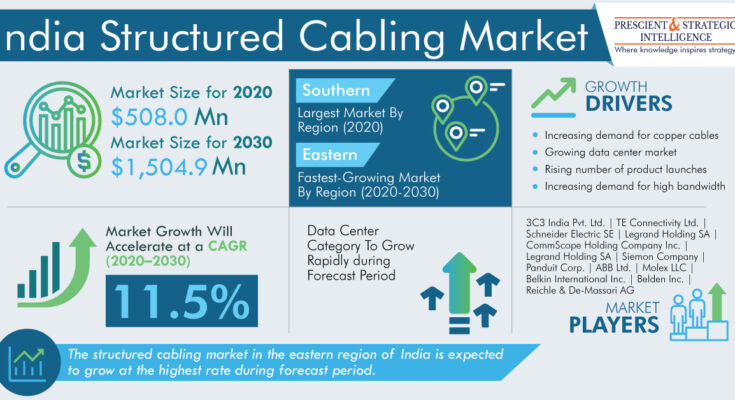A building’s or location’s telecommunications cable system, known as “structured cabling“, links computers, phones, WAP, cameras, and copiers to a data and phone network. It provides predictable performance, the adaptability to increase system availability and support upgrades and expansions.
As a result, it has many uses in the business, government, energy, industrial, healthcare, and transportation industries. Due to India’s expanding need for intelligent buildings, structured cabling usage is increasing.
One of the main reasons influencing the need for structured cabling in India is the expanding government’s attempts to create smart cities and offer free Wi-Fi in train stations.
India is now going through a fast digital revolution due to growth in the use of data in commercial decision-making processes. Thus, India structured cabling market is on track to hitting $1,504.9 million by 2030.
Structured cabling is also being used more often in India to offer essential support for high-performance and unified communication systems. This is helping the sector, as is the growing emphasis businesses place on improving their facilities and campuses.
Growing Digitization in India
The current digital revolution in India is driven by shifting corporate requirements and an increase in the use of data in decision-making. The IoT will be crucial to developing 100 smart towns created by the Indian government.
At the same time, as more businesses strive to upgrade their facilities and campuses while saving money and complying with the government’s smart building policy, there is a growing need for smart buildings in India.
The number of telecommunications businesses has increased dramatically in recent years due to the rising demand for data transmission networks, particularly in urban areas. The need for structured cabling in India is increasing due to the country’s fast digitalization since it provides the essential infrastructure for unified communication and high-performance systems.
Increasing Demand for High Bandwidth Biggest Driver
As internet usage has surged in India, so has the demand for greater bandwidth. For commercial activities to function properly, considerable bandwidth is required. Structured cabling makes this possible. Due to its improved data transmission capacity, cheap cost, and flexibility, the high-bandwidth ecosystem has developed exponentially.
The government, telecommunications, commercial, industrial, and other industries are paying attention to structured cabling since it is the building block of an effective IT system. Thus, the country’s need for structured cabling is being driven by the rising need for larger bandwidths.
Role of Data Center Network in the Industry
In addition to increasing the burden on the present communication infrastructure, the count of structured cabling customers, including governmental organizations, educational institutions, telecommunications firms, financial institutions, shops, and social networking services, is also rising.
The need for building automation and green data centers is anticipated to expand quickly in the future due to India’s digitalization. The introduction of mission-critical business programs, such as ERP and CRM, to external data centers, as well as the rising supply and falling price of high-bandwidth internet, are predicted to propel the expansion of the data center sector.




